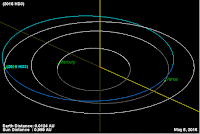Asteroid 2016 JC6 passed by the Earth at a distance of 4 922 000 km
(12.8 times the average distance between the Earth and the Moon, or
3.29% of the average distance between the Earth and the Sun), at about 4.25 pm GMT on Sunday 8 May 2016. There was no danger of
the asteroid hitting us, though had it done so it would have presented a
considerable threat. 2016 JC6 has an estimated equivalent
diameter of 100-330 m (i.e. a spherical body with the same mass would be 100-330 m in diameter), and an object of this size
would pass through the atmosphere and directly impact the ground with a
force of about 3.8-1500 megatons (about 225-90 000 times the
explosive energy of
the Hiroshima bomb), causing devastation over a wide area and creating a
crater 1.2-5 km across, and resulting in global climatic problems
that
could last for decades or even centuries.
Image showing 2016 JC6 taken on 4 May 2016 using the iTelescope 9 remote comtroled telescope at the Siding Spring Observatory in New South Wales. Image is a composite made of several diffent exposures; stars appear as a series of spots as they move across the field, the asteroid is a single spot (indicated by the arrow) as the telescope is being trained on this object. iTelescope T9/Marian Urbanic/Fotografický občasník.
2016 JC6 was discovered on 3 May 2016 (five days before its closest approach to the Earth) by the Southern Observatory for Near Earth Asteroids Research (SONEAR) at Oliviera in Minas Gerais State, Brazil. The
designation 2016 JC6 implies that it was the 153rd asteroid (asteroid C6)
discovered in the firt half of May 2016 (period 2016 J).
The calculated orbit of 2016 JC6. JPL Small Body Database.
2016 JC6 has a 265 day orbital period, with an elliptical orbit tilted at an angle of 6.80° to the plain of the Solar System which takes in to 0.58 AU from the Sun (58% of the distance at which the Earth orbits the Sun and considerably inside the orbit of the planet Venus) and out to 1.04 AU (4% further away from the Sun than the Earth). This means that close encounters between the asteroid and Earth are fairly common, with the last thought to have happened in October 2013 and the next predicted in December 2018. 2016 JC6 also has frequent close encounters with the planet Venus, with the last thought to have occurred in July 2014 and the next predicted for December 2026. Although it does cross the Earth's orbit and is briefly further from the Sun on each cycle, 2016 JC6 spends most of its time closer to the Sun than we are, and is therefore classified as an Aten Group Asteroid. As an asteroid possibly larger than 150 m in diameter that occasionally comes within 0.05 AU of the Earth, 2016 JC6 is also classified as a Potentially Hazardous Asteroid.
See also...
 Asteroid (388495) 2008 TZ3 passes the Earth. Asteroid
(388495)
2008 TZ3 passed by the Earth at a distance of 5 046 000 km
(13.1 times the average distance between the Earth and the Moon, or
3.37% of the average distance between the Earth and the...
Asteroid (388495) 2008 TZ3 passes the Earth. Asteroid
(388495)
2008 TZ3 passed by the Earth at a distance of 5 046 000 km
(13.1 times the average distance between the Earth and the Moon, or
3.37% of the average distance between the Earth and the... Asteroid 2016 HD3 passes the Earth. Asteroid
2016 HD3 passed by the Earth at a distance of 843 000 km (2.19 times
the average distance between the Earth and the Moon, or 0.56% of
the average distance between the Earth and the Sun), slightly before 6.10 am GMT on Monday 2 May...
Asteroid 2016 HD3 passes the Earth. Asteroid
2016 HD3 passed by the Earth at a distance of 843 000 km (2.19 times
the average distance between the Earth and the Moon, or 0.56% of
the average distance between the Earth and the Sun), slightly before 6.10 am GMT on Monday 2 May... Asteroid 2016 GD241 passes the Earth. Asteroid
2016 GD241 passed by the Earth at a distance of 7 643 000 km
(19.9 times the average distance between the Earth and the Moon, or
5.12% of the average distance between the Earth and the Sun), slightly
before 4.30 am GMT on Moday 2 May...
Asteroid 2016 GD241 passes the Earth. Asteroid
2016 GD241 passed by the Earth at a distance of 7 643 000 km
(19.9 times the average distance between the Earth and the Moon, or
5.12% of the average distance between the Earth and the Sun), slightly
before 4.30 am GMT on Moday 2 May...
Follow Sciency Thoughts on Facebook.


